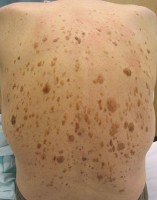01 Feb Topical Treatment On The Horizon For Common Warty Skin Growths
MedicalResearch.com Interview with:
Victor Allen Neel, MD, PhD
Director, Dermatologic Surgery
Massachusetts General Hospital
Medical Research: What is the background for this study?
Dr. Neel: Seborrheic keratoses (SKs) are the very common, warty brown skin lesions that are found on the face, chest and back of most people over forty. They affect every race and they increase in size and frequency with age. Although they are not dangerous, they can mimic dangerous conditions and are cosmetically unappealing. There is a high demand in the field of dermatology by both patients and physicians for a topical treatment. Currently there no FDA-approved drugs that have been shown to be effective at removing them.
Medical Research: What are the main findings?
Dr. Neel: Although seborrheic keratoses are the most common benign tumors in humans, very little was known about what causes them. Our paper was the first to study the biology of SKs in the laboratory, identify the key proteins controlling their abnormal growth and to pinpoint a potential treatment for commercial development.
We found that the enzyme called Akt was activated in seborrheic keratoses. Inhibiting this enzyme with a compound called A44 caused the SK cells to undergo “apoptosis,” or programmed cell death. Normal skin cells were unaffected by A44.
Medical Research: What should clinicians and patients take away from your report?
Dr. Neel: Currently, dermatologists can only treat seborrheic keratoses in the office with surgery or other traumatic procedures like laser or cautery (“burning”), cryotherapy (“freezing”) and curetting (“scraping”) — removing each lesion individually. These procedures are time-consuming, costly, painful and sometimes ineffective. Many patients have hundreds of lesions so it is impractical and financially prohibitive to remove all of their SKs. Our paper heralds the introduction of a topical treatment that could be used by patients at home to treat most, if not all, seborrheic keratoses.
Medical Research: What recommendations do you have for future research as a result of this study?
Dr. Neel: Future work will find an ideal vehicle with which to formulate A44 to safely deliver an effective dose to seborrheic keratoses topically.
Medical Research: Is there anything else you would like to add?
Dr. Neel: With the safe topical treatment of SKs, we hope to put treatment for this relatively benign but unsightly condition in the hands of patients.
Citation:
Sustained Akt activity is required to maintain cell viability in seborrheic keratosis, a benign epithelial tumor
Victor A. Neel1,, , Kristina Todorova2,Jun Wang2,Eunjeong Kwon2,Minjeong Kang2,Qingsong Liu3,Nathanael Gray3,Sam W. Lee2,4, Anna Mandinova2,4, 5, , Journal of Investigative Dermatology
Available online 29 December 2015
[wysija_form id=”5″]
Victor Allen Neel, MD, PhD (2016). Topical Treatment On The Horizon For Common Warty Skin Growths
Last Updated on February 1, 2016 by Marie Benz MD FAAD


